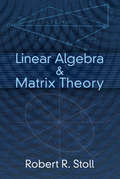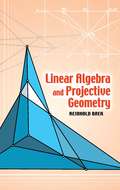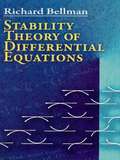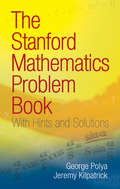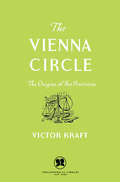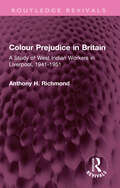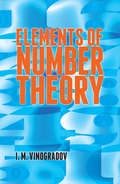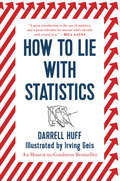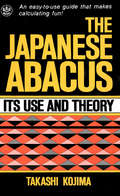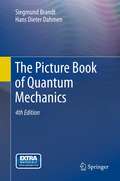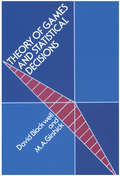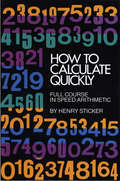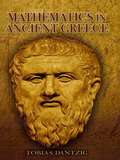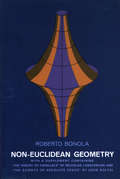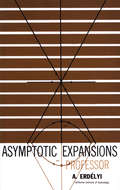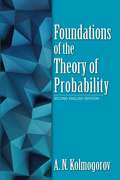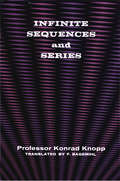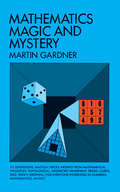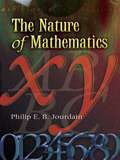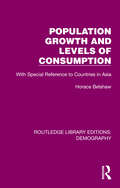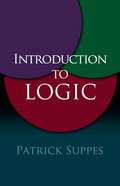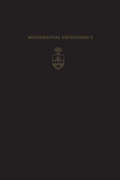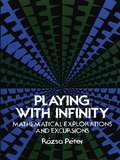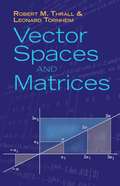- Table View
- List View
Linear Algebra and Matrix Theory (Dover Books on Mathematics)
by Robert R. StollOne of the best available works on matrix theory in the context of modern algebra, this text bridges the gap between ordinary undergraduate studies and completely abstract mathematics. The first five chapters treat topics important to economics, psychology, statistics, physics, and mathematics. Final chapters apply chiefly to students of engineering, physics, and advanced mathematics. 1952 edition.
Linear Algebra and Projective Geometry
by Reinhold BaerGeared toward upper-level undergraduates and graduate students, this text establishes that projective geometry and linear algebra are essentially identical. The supporting evidence consists of theorems offering an algebraic demonstration of certain geometric concepts. These focus on the representation of projective geometries by linear manifolds, of projectivities by semilinear transformations, of collineations by linear transformations, and of dualities by semilinear forms. These theorems lead to a reconstruction of the geometry that constituted the discussion's starting point, within algebraic structures such as the endomorphism ring of the underlying manifold or the full linear group.Restricted to topics of an algebraic nature, the text shows how far purely algebraic methods may extend. It assumes only a familiarity with the basic concepts and terms of algebra. The methods of transfinite set theory frequently recur, and for readers unfamiliar with this theory, the concepts and principles appear in a special appendix.
Stability Theory of Differential Equations (Dover Books on Mathematics)
by Richard BellmanSuitable for advanced undergraduates and graduate students, this was the first English-language text to offer detailed coverage of boundedness, stability, and asymptotic behavior of linear and nonlinear differential equations. It remains a classic guide, featuring material from original research papers, including the author's own studies.The linear equation with constant and almost-constant coefficients receives in-depth attention that includes aspects of matrix theory. No previous acquaintance with the theory is necessary, since author Richard Bellman derives the results in matrix theory from the beginning. In regard to the stability of nonlinear systems, results of the linear theory are used to drive the results of Poincaré and Liapounoff. Professor Bellman then surveys important results concerning the boundedness, stability, and asymptotic behavior of second-order linear differential equations. The final chapters explore significant nonlinear differential equations whose solutions may be completely described in terms of asymptotic behavior. Only real solutions of real equations are considered, and the treatment emphasizes the behavior of these solutions as the independent variable increases without limit.
The Stanford Mathematics Problem Book: With Hints and Solutions (Dover Books on Mathematics)
by G. Polya J. KilpatrickThis volume features a complete set of problems, hints, and solutions based on Stanford University's well-known competitive examination in mathematics. It offers high school and college students an excellent mathematics workbook of rigorous problems that will assist in developing and cultivating their logic and probability skills.These 20 sets of intriguing problems test originality and insight rather than routine competence. They involve theorizing and verifying mathematical facts; examining the results of general statements; discovering that highly plausible conjectures can be incorrect; solving sequences of subproblems to reveal theory construction; and recognizing "red herrings," in which obvious relationships among the data prove irrelevant to solutions. Hints for each problem appear in a separate section, and a final section features solutions that outline the appropriate procedures.Ideal for teachers seeking challenging practice math problems for their gifted students, this book will also help students prepare for mathematics, science, and engineering programs. Mathematics buffs of all ages will also find it a source of captivating challenges.
The Vienna Circle: The Origins of Neo-Positivism
by Victor KraftJoin original Vienna Circle member Victor Kraft in his discussion of the movement for an exclusive insider&’s view of this important point in philosophical history. In this in-depth philosophical study, Victor Kraft explores the role the Vienna Circle had on the international philosophical movement. The Vienna Circle constituted a point of departure for the reawaking, rebirth, and reformation of positivism and empiricism, leading to the creation of the Neo-positivism movement. At the time of The Vienna Circle&’s publication in the 1950s, the Neo-positivism movement stood in the foreground of contemporary philosophy, and it was quite possibly the most significant serious philosophical movement in the period between the two world wars. Making Kraft&’s study of Neo-positivism available to a world audience, Arthur Pap provides a rich and accessible translation from the original German. The book contains detailed expositions, accompanied here and there by criticism, of the Vienna Circle&’s views on the criteria of significance, the nature of logic and mathematics, the phenomenalist analysis of physical concepts, the verification-basis of scientific propositions, the meaning of probability, physicalism, and much more.
Colour Prejudice in Britain: A Study of West Indian Workers in Liverpool, 1941-1951 (Routledge Revivals)
by Anthony H. RichmondFirst published in 1954, Colour Prejudice in Britain is an account of the assimilation and adjustment of 345 West Indian workers who came to England between 1941 and 1943, many of whom have stayed to the present day. The study endeavours to trace the relationships between this group of West Indians and the English people with whom they came in contact over a period of approximately ten years. It is therefore a study in the two related fields of immigration and racial relations. This book will be of interest to students of sociology, history, and ethnic studies.
Elements of Number Theory
by I. M. Vinogradov"A very welcome addition to books on number theory."--Bulletin, American Mathematical SocietyClear and detailed in its exposition, this text can be understood by readers with no background in advanced mathematics; only a small part requires a working knowledge of calculus. One of the most valuable characteristics of this book is its stress on learning number theory by means of demonstrations and problems. More than 200 problems and full solutions appear in the text, plus 100 numerical exercises. Some of these exercises deal with estimation of trigonometric sums and are especially valuable as introductions to more advanced studies. Translation of 1949 Russian edition.
How to Lie with Statistics (Pelican Ser.)
by Darrell Huff Irving GeisOver Half a Million Copies Sold--an Honest-to-Goodness Bestseller Darrell Huff runs the gamut of every popularly used type of statistic, probes such things as the sample study, the tabulation method, the interview technique, or the way the results are derived from the figures, and points up the countless number of dodges which are used to full rather than to inform.
Japanese Abacus Use & Theory
by Takashi KojimaThe Japanese Abacus & Theory book is easy to follow, and gives the reader step-by-step directions on how to use it correctly while applying it to practical use. The imperfect numerical notation and scarcity of suitable writing materials in ancient times are presumed to have given rise to need for devices of mechanical calculation. While the definite origin of the abacus is obscure, there is some reason for believing that its earliest form reckoning table covered with sand or fine dust, in which figures were drawn with a stylus, to be erased with the figure when necessary. Though the Abacus is an older tool for calculation it still is used today in Japan taking on a different name called Soroban. Though the Japanese Abacus or Soroban may appear mysterious or even primitive to those raised in the age of pocket calculators and desktop computers, this intriguing tool is capable of amazing speed and accuracy. It is still widely used throughout the shops and markets of Asia, and its popularity shows no sign of decline. Here for the first time in English is a complete explanation of how to use the abacus.
The Picture Book of Quantum Mechanics
by Hans Dieter Dahmen Siegmund BrandtThe aim of this book is to explain the basic concepts and phenomena of quantum mechanics by means of visualization. Computer-generated illustrations in color are used extensively throughout the text, helping to establish the relation between quantum mechanics--wave functions, interference, atomic structure, and so forth--and classical physics--point mechanics, statistical mechanics, and wave optics. Even more important, by studying the pictures in parallel with the text, readers develop an intuition for such notoriously abstract phenomena as the tunnel effect excitation and decay of metastable states wave-packet motion within a well systems of distinguishable and indistinguishable particles free wave packets and scattering in 3 dimensions angular-momentum decomposition stationary bound states in various 3-dimensional potentials hybrid states Kepler motion of wave packets in the Coulomb field spin and magnetic resonance Illustrations from experiments in a variety of fields, including chemistry, and molecular, atomic, nuclear, and particle physics, underline the basic as well as the practical importance of quantum mechanics. In the present, fourth edition all computer graphics are presented in full color. It also contains additional physics topics such as hybridization. Praise for Previous Editions "The book is highly recommended as a complement to any standard textbook in quantum mechanics, but it will also be valuable to all of us who studied quantum mechanics without the pictures." -- International Journal of Quantum Chemistry "This book would be an excellent basis for the study of special topics in a quantum physics course. Most serious students of physics and all of their teachers will want to consider having this orderly and graphic outline of introductory quantum theory at their fingertips." -- American Journal of Physics "Their aim is the presentation of the 'principal ideas of wave mechanics' in such a way that students can build a quantum intuition out of their graphics." -- Scientific American "This is a unique book. It does not provide a complete course in quantum theory, but as a companion work of reference it should be quite useful to students in providing insights into the dynamical structure of the theory." -- Nature
Theory of Games and Statistical Decisions (Dover Books on Mathematics)
by David A. Blackwell M. A. GirshickEvaluating statistical procedures through decision and game theory, as first proposed by Neyman and Pearson and extended by Wald, is the goal of this problem-oriented text in mathematical statistics. First-year graduate students in statistics and other students with a background in statistical theory and advanced calculus will find a rigorous, thorough presentation of statistical decision theory treated as a special case of game theory.The work of Borel, von Neumann, and Morgenstern in game theory, of prime importance to decision theory, is covered in its relevant aspects: reduction of games to normal forms, the minimax theorem, and the utility theorem. With this introduction, Blackwell and Professor Girshick look at: Values and Optimal Strategies in Games; General Structure of Statistical Games; Utility and Principles of Choice; Classes of Optimal Strategies; Fixed Sample-Size Games with Finite Ω and with Finite A; Sufficient Statistics and the Invariance Principle; Sequential Games; Bayes and Minimax Sequential Procedures; Estimation; and Comparison of Experiments.A few topics not directly applicable to statistics, such as perfect information theory, are also discussed. Prerequisites for full understanding of the procedures in this book include knowledge of elementary analysis, and some familiarity with matrices, determinants, and linear dependence. For purposes of formal development, only discrete distributions are used, though continuous distributions are employed as illustrations.The number and variety of problems presented will be welcomed by all students, computer experts, and others using statistics and game theory. This comprehensive and sophisticated introduction remains one of the strongest and most useful approaches to a field which today touches areas as diverse as gambling and particle physics.
How to Calculate Quickly: Full Course in Speed Arithmetic (Dover Books on Mathematics)
by Henry StickerDo you want to double or triple the speed with which you calculate? How to Calculate Quickly is a tried and true method for helping you in the mathematics of daily life -- addition, subtraction, multiplication, division, and fractions. The author can awaken for you a faculty which is surprisingly dormant in accountants, engineers, scientists, businesspeople, and others who work with figures. This is "number sense" -- or the ability to recognize relations between numbers considered as whole quantities. Lack of this number sense makes it entirely possible for a scientist to be proficient in higher mathematics, but to bog down in the arithmetic of everyday life. This book teaches the necessary mathematical techniques that schools neglect to teach: Horizontal addition, left to right multiplication and division, etc. You will learn a method of multiplication so rapid that you'll be able to do products in not much more time than it would take to write the problem down on paper. This is not a collection of tricks that work in only a very few special cases, but a serious, capably planned course of basic mathematics for self-instruction. It contains over 9,000 short problems and their solutions for you to work during spare moments. Five or ten minutes spent daily on this book will, within ten weeks, give you a number sense that will double or triple your calculation speed.
Mathematics in Ancient Greece (Dover Books on Mathematics)
by Tobias DantzigMore than a history of mathematics, this lively book traces mathematical ideas and processes to their sources, stressing the methods used by the masters of the ancient world. Author Tobias Dantzig portrays the human story behind mathematics, showing how flashes of insight in the minds of certain gifted individuals helped mathematics take enormous forward strides. Dantzig demonstrates how the Greeks organized their precursors' melange of geometric maxims into an elegantly abstract deductive system. He also explains the ways in which some of the famous mathematical brainteasers of antiquity led to the development of whole new branches of mathematics.A book that will both instruct and delight the mathematically minded, this volume is also a treat for readers interested in the history of science. Students and teachers of mathematics will particularly appreciate its unusual combination of human interest and sound scholarship.
Non-Euclidean Geometry: A Critical And Historical Study Of Its Development (1912) (Dover Books on Mathematics)
by Roberto BonolaThis is an excellent historical and mathematical view by a renowned Italian geometer of the geometries that have risen from a rejection of Euclid's parallel postulate. Students, teachers and mathematicians will find here a ready reference source and guide to a field that has now become overwhelmingly important.Non-Euclidean Geometry first examines the various attempts to prove Euclid's parallel postulate-by the Greeks, Arabs, and mathematicians of the Renaissance. Then, ranging through the 17th, 18th and 19th centuries, it considers the forerunners and founders of non-Euclidean geometry, such as Saccheri, Lambert, Legendre, W. Bolyai, Gauss, Schweikart, Taurinus, J. Bolyai and Lobachevski. In a discussion of later developments, the author treats the work of Riemann, Helmholtz and Lie; the impossibility of proving Euclid's postulate, and similar topics. The complete text of two of the founding monographs is appended to Bonola's study: "The Science of Absolute Space" by John Bolyai and "Geometrical Researches on the Theory of Parallels" by Nicholas Lobachevski. "Firmly recommended to any scientific reader with some mathematical inclination" -- Journal of the Royal Naval Scientific Service. "Classic on the subject." -- Scientific American.
Asymptotic Expansions (Dover Books on Mathematics)
by A. ErdélyiOriginally prepared for the Office of Naval Research, this important monograph introduces various methods for the asymptotic evaluation of integrals containing a large parameter, and solutions of ordinary linear differential equations by means of asymptotic expansions. Author's preface. Bibliography.
Foundations of the Theory of Probability: Second English Edition (Dover Books on Mathematics)
by A. N. Kolmogorov Nathan MorrisonThis famous little book was first published in German in 1933 and in Russian a few years later, setting forth the axiomatic foundations of modern probability theory and cementing the author's reputation as a leading authority in the field. The distinguished Russian mathematician A. N. Kolmogorov wrote this foundational text, and it remains important both to students beginning a serious study of the topic and to historians of modern mathematics. Suitable as a text for advanced undergraduates and graduate students in mathematics, the treatment begins with an introduction to the elementary theory of probability and infinite probability fields. Subsequent chapters explore random variables, mathematical expectations, and conditional probabilities and mathematical expectations. The book concludes with a chapter on the law of large numbers, an Appendix on zero-or-one in the theory of probability, and detailed bibliographies.
Fourier Series (Dover Books on Mathematics #1)
by G. H. Hardy W. W. RogosinskiGeared toward mathematicians already familiar with the elements of Lebesgue's theory of integration, this classic, graduate-level text begins with a brief introduction to some generalities about trigonometrical series. Discussions of the Fourier series in Hilbert space lead to an examination of further properties of trigonometrical Fourier series, concluding with a detailed look at the applications of previously outlined theorems. Ideally suited for both individual and classroom study.
Infinite Sequences and Series
by Konrad KnoppOne of the finest expositors in the field of modern mathematics, Dr. Konrad Knopp here concentrates on a topic that is of particular interest to 20th-century mathematicians and students. He develops the theory of infinite sequences and series from its beginnings to a point where the reader will be in a position to investigate more advanced stages on his own. The foundations of the theory are therefore presented with special care, while the developmental aspects are limited by the scope and purpose of the book. All definitions are clearly stated; all theorems are proved with enough detail to make them readily comprehensible. The author begins with the construction of the system of real and complex numbers, covering such fundamental concepts as sets of numbers and functions of real and complex variables. In the treatment of sequences and series that follows, he covers arbitrary and null sequences; sequences and sets of numbers; convergence and divergence; Cauchy's limit theorem; main tests for sequences; and infinite series. Chapter three deals with main tests for infinite series and operating with convergent series. Chapters four and five explain power series and the development of the theory of convergence, while chapter six treats expansion of the elementary functions. The book concludes with a discussion of numerical and closed evaluation of series.
Mathematics, Magic and Mystery
by Martin GardnerWhy do card tricks work? How can magicians do astonishing feats of mathematics mentally? Why do stage "mind-reading" tricks work? As a rule, we simply accept these tricks and "magic" without recognizing that they are really demonstrations of strict laws based on probability, sets, number theory, topology, and other branches of mathematics.This is the first book-length study of this fascinating branch of recreational mathematics. Written by one of the foremost experts on mathematical magic, it employs considerable historical data to summarize all previous work in this field. It is also a creative examination of laws and their exemplification, with scores of new tricks, insights, and demonstrations. Dozens of topological tricks are explained, and dozens of manipulation tricks are aligned with mathematical law.Nontechnical, detailed, and clear, this volume contains 115 sections discussing tricks with cards, dice, coins, etc.; topological tricks with handkerchiefs, cards, etc.; geometrical vanishing effects; demonstrations with pure numbers; and dozens of other topics. You will learn how a Moebius strip works and how a Curry square can "prove" that the whole is not equal to the sum of its parts.No skill at sleight of hand is needed to perform the more than 500 tricks described because mathematics guarantees their success. Detailed examination of laws and their application permits you to create your own problems and effects.
The Nature of Mathematics
by Philip E. JourdainAnyone with an interest in mathematics will welcome the republication of this little volume by a remarkable mathematician who was also a logician, a philosopher, and an occasional writer of fiction and poetry. Originally published in 1913, and later included in the acclaimed anthology The World of Mathematics, Jourdain's survey shows how and why the methods of mathematics were developed, traces the development of mathematical science from the earliest to modern times, and chronicles the application of mathematics to natural science.Starting with the ancient Egyptians and Greeks, the author profiles mathematics' rise and progress with the development of analytical methods by Descartes, Galileo, Newton, Leibnitz, and others. The text focuses on principles rather than techniques, exploring the foundations of algebra, analytical geometry, and the method of indivisibles. It discusses the beginnings of the correlation of mathematics and natural science in the study of dynamics as well as the emergence of modern mathematics with the infinitesimal calculus. Additional topics include contemporary views of limits and numbers and a brief summation of the nature of mathematics.
Population Growth and Levels of Consumption: With Special Reference to Countries in Asia (Routledge Library Editions: Demography #1)
by Belshaw HoraceOriginally published in 1956, this book considers the practical problems of economic development in countries in which the prevailing outlook and a recent or probable increase in population growth make it difficult to escape from a ‘Malthusian situation.’ This book develops a valuable analytical apparatus with which it then examines the problems of capital formation, investment, economies of scale and the effective supply of labour, all in relation to population growth. Social, institutional and cultural factors are integrated with the economic.
Introduction to Logic
by Patrick SuppesPart I of this coherent, well-organized text deals with formal principles of inference and definition. Part II explores elementary intuitive set theory, with separate chapters on sets, relations, and functions. Ideal for undergraduates.
Non-Euclidean Geometry (Mathematical Expositions #2)
by H.S.M. CoxeterThe name non-Euclidean was used by Gauss to describe a system of geometry which differs from Euclid's in its properties of parallelism. Such a system was developed independently by Bolyai in Hungary and Lobatschewsky in Russia, about 120 years ago. Another system, differing more radically from Euclid's, was suggested later by Riemann in Germany and Cayley in England. The subject was unified in 1871 by Klein, who gave the names of parabolic, hyperbolic, and elliptic to the respective systems of Euclid-Bolyai-Lobatschewsky, and Riemann-Cayley. Since then, a vast literature has accumulated. The Fifth edition adds a new chapter, which includes a description of the two families of 'mid-lines' between two given lines, an elementary derivation of the basic formulae of spherical trigonometry and hyperbolic trigonometry, a computation of the Gaussian curvature of the elliptic and hyperbolic planes, and a proof of Schlafli's remarkable formula for the differential of the volume of a tetrahedron.
Playing with Infinity: Mathematical Explorations And Excursions (Dover Books on Mathematics)
by Rózsa PéterThis popular account of the many mathematical concepts relating to infinity is one of the best introductions to this subject and to the entire field of mathematics. Dividing her book into three parts -- The Sorcerer's Apprentice, The Creative Role of Form, and The Self-Critique of Pure Reason -- Peter develops her material in twenty-two chapters that sound almost too appealing to be true: playing with fingers, coloring the grey number series, we catch infinity again, the line is filled up, some workshop secrets, the building rocks, and so on.Yet, within this structure, the author discusses many important mathematical concepts with complete accuracy: number systems, arithmetical progression, diagonals of convex polygons, the theory of combinations, the law of prime numbers, equations, negative numbers, vectors, operations with fractions, infinite series, irrational numbers, Pythagoras' Theorem, logarithm tables, analytical geometry, the line at infinity, indefinite and definite integrals, the squaring of the circle, transcendental numbers, the theory of groups, the theory of sets, metamathematics, and much more. Numerous illustrations and examples make all the material readily comprehensible.Without being technical or superficial, the author writes with complete clarity and much originality on the whole range of topics from counting to mathematical logic. Using little algebra and no mathematical formulas, she has written an unusual book that will interest even mathematicians and teachers. Beginning mathematics students and people in the humanities and other fields will find the book particularly outstanding for their purposes.
Vector Spaces and Matrices
by Leonard Tornheim Robert M. ThrallThis volume is suitable as a primary or supplementary text for college-level courses in linear algebra. It possesses the distinct advantage of approaching the subject simultaneously at two levels, the concrete and the axiomatic. Students thus receive the benefits of axiom-based mathematical reasoning as well as a grasp of concrete formulations. 1957 edition.
